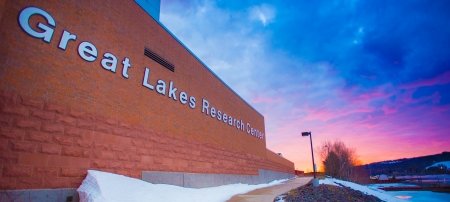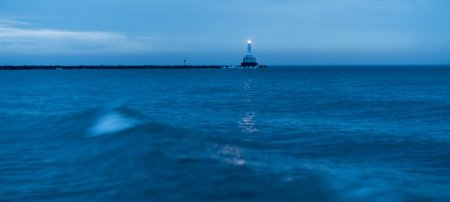Andrew Barnard '02 '04 has been all about that bass, that treble, and all frequencies in between ever since he was a kid growing up in Door County, Wisconsin.
“I was a musician, so I was into acoustics without even knowing it,” says Barnard, an assistant professor of mechanical engineering–engineering mechanics with an ear for the sounds of science.
His avocation got an early start, beginning with six years of piano lessons followed by playing in his high school band (three different instruments). He also sings tenor in the Michigan Tech Concert Choir and, back in 2001, as the wag Nicely Nicely in Tech’s staging of Guys and Dolls.
“I’ve always liked sound,” he says, but never imagined making it his profession. That changed when he enrolled in former mechanical engineering professor Mohan Rao’s acoustics and noise control class. “He sparked my interest,” says Barnard. “I realized I could take my hobbies and engineering and mesh them together in a career.”

After completing a BS in Mechanical Engineering–Engineering Mechanics and an MS in Mechanical Engineering at Michigan Tech, Barnard left for the only university in the country that offered a PhD in acoustics. At Penn State, he earned his doctorate and found a home in the Applied Research Lab, which is partially funded by the US Navy. There, his work focused on silence, reducing noise of naval vessels, torpedoes, and other underwater hardware.
Then one morning in July 2014, Barnard heard from Michigan Tech. Would he like to apply for the faculty position recently vacated by his mentor, Mohan Rao?
It wasn’t a tough decision. “I grew up on the Door Peninsula, and I worked all summer at my grandparents’ resort in Egg Harbor,” he says. “I missed the big water.”
He would also be able to widen his perspective. Now, his research repertoire at the University ranges from exploring the underwater soundscape of the Great Lakes to acoustic applications of carbon nanotube thin films.
“I like to try new stuff,” Barnard says. “Whatever it is, if it has anything to do with sound, I’m interested. I’ll work on anything.”
Cool Sounds, Hot Nanotubes
Next to Barnard’s computer is a small device that looks vaguely like a pair of mini goalposts. Two pencil-sized copper rods are mounted on a stand, with a band of transparent black gauze stretched between them. He double clicks on a sound file, and the device begins whispering AC/DC’s “Back in Black.”
The gauze is actually an ultra-thin sheet of aligned nanotubes called a carbon nanotube thermophone, which can warm up and cool down up to 100,000 times a second when plugged into a power source. That heating and cooling causes the adjacent air to expand and contract, pushing air molecules around and making sound waves.
Why a nanotube speaker instead of the usual kind? It’s flexible and stretchable, with no moving parts, and you can put it practically anywhere. Plus, it weighs next to nothing. Four ounces of the material will cover an acre.
Those attributes might also make it a go-to material for the auto industry, which is eyeing active noise control technologies that can make any vehicle rumble like a ’69 Camaro.
"Two summers ago, we could hear the prop on an ore boat, a 1000-footer, from 60 to 100 miles away."
Active noise control can quiet a vehicle’s exhaust system by neutralizing noise with noise, a bit like a matter/anti-matter reaction. Sometimes, however, drivers don’t want to run silent. Sometimes they want to imagine they are idling at the start of the Indy 500.
“The hot new thing for exhaust systems is to tailor the sound,” says Barnard, whose group is engineering just such a system using nanotube thin films. Its work is being supported by a Michigan Translational Research and Commercialization grant from the Michigan Economic Development Corporation and by Michigan Tech’s Research Excellence Fund. “And we’re talking with some top-tier suppliers interested in funding the research further,” Barnard says.
Shh! Hard Drives at Work
Sometimes, too much noise makes computer hard drives fail. So, when the people at Tyco Fire Protection Products in Marinette, Wisconsin, discovered that the loud whoosh of their fire extinguishing system was hurting hard drives, they came to Barnard to find out why.
You can’t use sprinklers to put out a fire in a room full of electronics. Instead, Tyco forces inert gas through a nozzle into the space, displacing the air and smothering the blaze. “But that nozzle was making a lot of noise, so in trying to protect the hard drives from fire, they were damaging them with sound,” Barnard says.
To determine what was going on, his team blasted hard drives with various sound frequencies and volumes. When they identified what made them fail, they gave their results to Tyco.
“They came up with a nice, quiet nozzle design,” Barnard says. And together they published a white paper on the subject, so other manufacturers can design systems that play nice with hard drives.
Navy Labs Offer New Career Path for Michigan Tech Grads
Think of careers in the Navy, and “engineer” probably isn’t at the top of the list. Barnard expects to change that at Michigan Tech.

With a $600,000 grant from the US Navy, Barnard is establishing a Naval Systems Experience program at the University. The aim is to interest students in civilian careers in Navy research labs, which, like auto companies, hire lots of engineering graduates for a multitude of design projects.
Barnard is collaborating with other faculty members to develop a minor in naval systems engineering. He is also working to connect Tech students with staff at research labs and interest them in civilian Navy careers. He’s even putting together a Summer Youth Program session in marine technology.
The grant is also helping to support the new SENSE Enterprise (Strategic Education through Naval Systems Experiences). For their first project, the team is developing a near-shore robotic rescue device.
“It would go out and provide flotation for someone who is about to drown,” Barnard says. The robot would be guided by a first responder, and while it would work on any shoreline, it’s specifically designed for the Great Lakes.
“On the East and West Coasts, there are lots of trained water rescuers, but not on the Great Lakes,” he said. Too often, someone drowns for lack of life-saving assistance, or worse, an untrained first responder tries to help and they both drown. “It’s a bad situation.”
The idea of the robotic lifesaver was first floated by Aanikoosing Inc., The economic development company is affiliated with the Keweenaw Bay Indian Community, which borders plenty of shoreline. “It’s a terrific concept,” Barnard says. “It falls well within our Navy purview, and it helps out a local community.
Voices of the Big Lakes
It’s noisy in the depths of the Great Lakes, but no one knows exactly how noisy. Barnard is among those aiming to find out.
“We have a wealth of acoustic knowledge on the oceans, because the military has been interested since the 1940s,” he says. “But we don’t know much about the Great Lakes, because submarines don’t go there.”
Two winters ago, Barnard worked with Michigan Tech’s Great Lakes Research Center to install an under-ice microphone system, gathering information on everything from the track noise of snowmobiles to the crackle of breaking ice.

In all weather, he heads out to sample the sounds of Lake Superior: background noises, ice noises, the sounds of shipping traffic, and power plants on shore.
“Some of those sounds propagate across the whole lake,” he says. “Two summers ago, we could hear the prop on an ore boat, a 1,000-footer, from 60 to 100 miles away.”
Last summer, he spent five days aboard NOAA’s Research Vessel Blue Heron, part of the University-National Oceanographic Laboratory System, gathering sonic information from Lakes Michigan and Superior. In addition to taking sound measurements, he also learned about such matters as seasickness and the perils of leaving an expensive underwater instrument untended while the boat makes a hard turn. (You lose it.) Barnard journaled about his experiences in Michigan Tech’s research blog, Unscripted.
Why go to all the trouble? Sounds affect the underwater environment and human communication systems. They might also be affecting fish, specifically, efforts to count them.
Government agencies estimate fish numbers using sonar systems in boats. Lately, Barnard has been working with Guy Meadows, director of the Great Lakes Research Center, to see if noise from those boats could be skewing fish census numbers, which are used to write fishing regulations.
“Some of those boats are old chuggers,” says Barnard. “Could we be driving fish away before we can count?”
There’s also a wider reason to delve into the sounds of the watery world off Michigan Tech’s shoreline.
“Lake Superior has been speaking to us for centuries,” Meadows says. “Now we’re finally beginning to listen.”
Michigan Technological University is an R1 public research university founded in 1885 in Houghton, and is home to nearly 7,500 students from more than 60 countries around the world. Consistently ranked among the best universities in the country for return on investment, Michigan's flagship technological university offers more than 120 undergraduate and graduate degree programs in science and technology, engineering, computing, forestry, business, health professions, humanities, mathematics, social sciences, and the arts. The rural campus is situated just miles from Lake Superior in Michigan's Upper Peninsula, offering year-round opportunities for outdoor adventure.




